CREATIVE
Q: Tell us a little about yourself. Who are you and what do you do?
A: I was born in Holland in 1953, lived in Rhodesia for 6 years, returned to Holland in 1963 and moved to the UK in 1974, where I lived for 40 years. I became on their foremost motoring artists from 1983 onwards and booked many successes through many exhibitions, countless magazine and newspaper articles, fine art prints, book covers and several television appearances. I am also totally self-taught.
I now live in Phoenix, Arizona and from where I intend to build up my reputation as an innovative and contemporary artist in the USA and beyond.
Q: What art technique do you use, and what motivated you to use that technique?
A: I pioneered the use of ‘photo realism’ in motoring art when living in the UK, something motoring artists had not yet done before. Using a difficult and challenging medium which also had never been used in motoring art – enamel paints. They offered a purely smooth surface and bright colors are easily available, totally suited to the brightness of motor racing. I now use acrylic based paints and which have the advantage of allowing a much more spontaneous working ethos.
Q: When did you decide you wanted to be an artist? And has the internet become a good or bad aspect to life as an artist?
A: Knowing that a part of my father’s family were successful artists, was certainly an ever-present spark. Realizing that I’d never become a racing driver, I poured my passion into depicting them instead. I was kicked into a sudden direction in 1968 – but that is a long story.
I was never a child prodigy like some other artists. I started late, possibly around my mid teens and the people around me treated my aspirations with indulgent kindness. I never developed a self-identity until much later.
The internet has become a two-edged sword but it is up to the individual artist to allow him/herself as how to use that blade. I use it to the best of my abilities and seek out people who can help me use it even more. The possibilities are absolutely limitless and should not frighten you. Obtaining reference material now takes seconds, instead of days, weeks or months.
The advent of the internet has sen a remarkable and welcome change in the way the world perceives galleries.
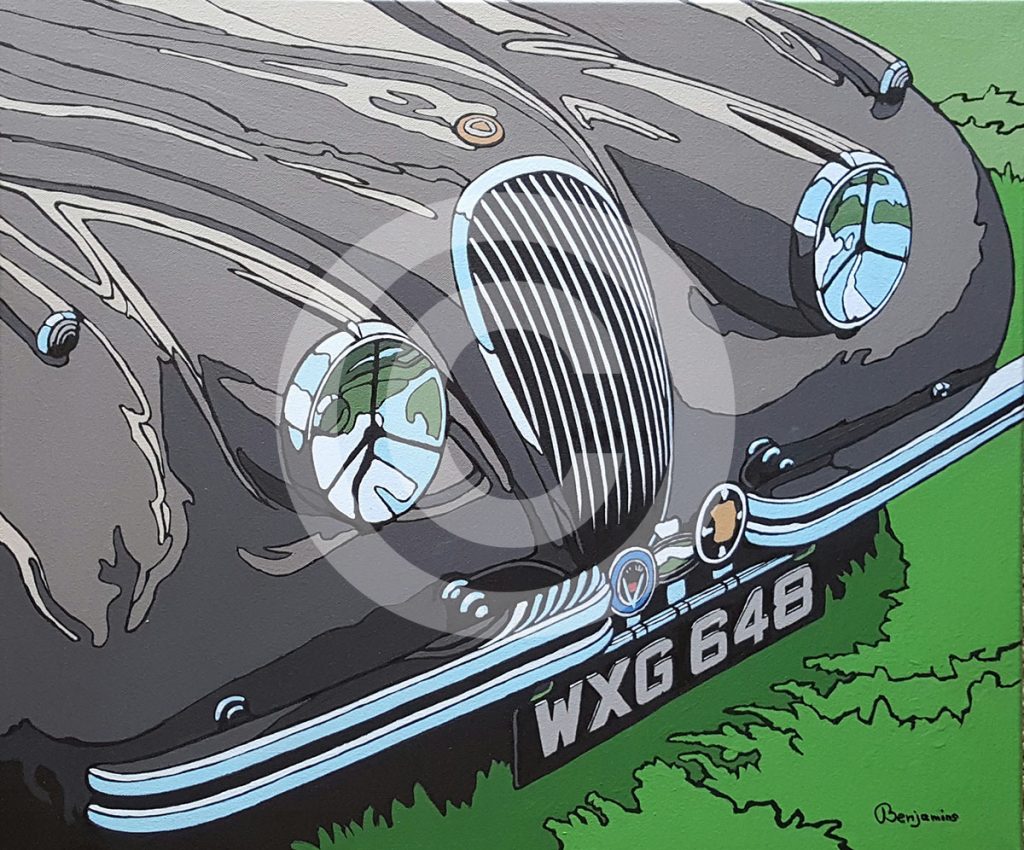
copyright © Arthur Benjamins
Q: What do you dislike about the world of art?
A: The ‘world of art’s’ bullshit factor has reached stratospheric levels. In the 1950s, artists used to discuss whether or not one’s work fitted inside the genre or movement to which you had affiliated yourself. This BS factor has now rested with the very few self-appointed ‘movers and shakers’ and who control galleries and museums. Naturally, ALL galleries must be commercially viable, but despite the fact that an artist fully understands all those aspects, galleries still choose to push fashionable dross. They are no longer the vanguards of art – and they know it.
In order to play down their role in the arts current deconstruction, the ‘decision makers’ lead you to believe that much of the ‘established’ art has been accorded a reverence by the educated middle class. This is all hot air. It is like an over-inflated balloon which I cannot resist pricking.
The World of Art is in utter disarray, and I am one of the many standing at the sidelines laughing and awaiting to pick their bones clean.
Q: What is the toughest thing about being an artist?
A: Any artist who claims that they are not seeking an audience is lying. We sell our souls to ones who have polarized ideas and passions, conversely hoping they will listen. Once an artist realizes that the world sees them as entertainment – as monkeys in a cage, ready to be poked with sticks – a large burden will fall off their shoulders. The world no longer looks at artists as a barometer of social issues, or that it allows its hackles to be raised, warranting ostracizing or widespread condemnation. There has been nothing new since the 1960s. Copyists are being championed through galleries, time and time again.
It depends on the individual artist how they allow prevailing attitudes to effect them. I have become stronger, resilient and utterly determined to spread my own gospel and with the sterling assistance of the ones who want to listen, write my own ticket to success.
Q: What’s your message to the World?
A: I don’t think that anyone could view my work as a carrier of any social message or comment. In fact I’m not interested in making any comments or statements on that plateau. I’m not interested in teaching, preaching, changing or bettering the world in any way through my paintings – but merely for the viewer to like, hate, buy – or come away with even more curiosity than they arrived.
INFRINGEMENT
Q: What was your first case of a piece of art being infringed upon?
A: It were my friends who began to alert me that my work had appeared on eBay or through other ways. My work was always of a dubious quality, reduced in size with my signature cropped off. Once my work began to appear in magazines through articles and features, their necessary cropping usually meant my signature in the bottom of the image was lost. I therefore began to sign my works more prominent, so that cropping would not effect its provenance.
I believe it was one of my speed record breakers which had appeared in a format so cropped and small that it could never convey its true impact. I sent an email and they removed it.
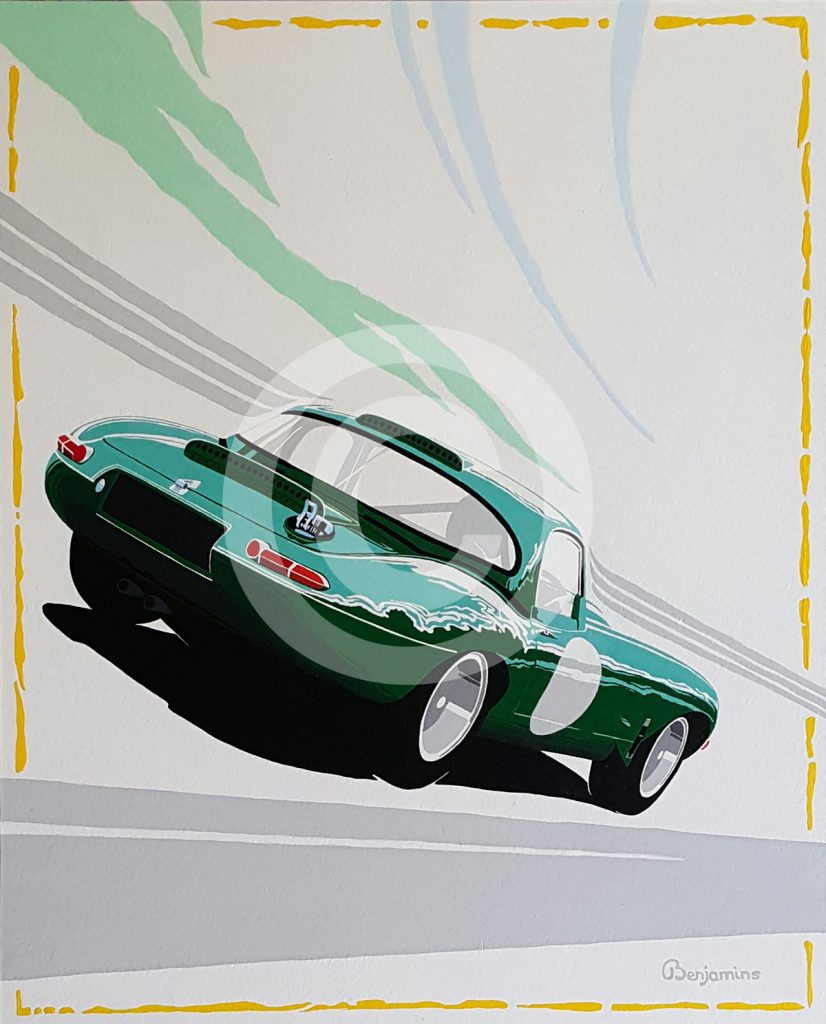
copyright © Arthur Benjamins
Q: How did you feel about someone stealing your artwork and making money from your hard work?
A: I have not (yet) experienced someone stealing my work and using it for their own end. However, I have met quite a few artists who have had their work abused. The problem is, that in this regard I do like a good fight and pull no punches when it comes to making contact with the offenders. I am a good letter/email writer.
A world famous Swiss maker of time pieces (!) some years ago, blatantly used the idea of one of my images for one of their adverts in a leading UK motoring magazine. I KNOW they knew of that painting as I had donated it to a charity fund with connections to them, and that it was bought by a large company. I wrote to their marketing director with all the proof and photographs, but who never acknowledged my letter.
If there was ever any admission of guilt, that was it.
Although they directly didn’t use my image, they infringed intellectual copyright and which is a completely different matter.
I have placed a great deal of my images on the internet. They are all clearly associated with myself and my name. Many of those images are bound to me by the sheer fact that their ideas of inception are totally mine and I have considered trademarking some of these. One may have the considerable outlay to obtain a trade mark, but policing it and battling an infringement in court is not an option many can afford.
Q: Do you feel it’s a necessary part of the market, to allow for free advertising?
A: You may wish to rephrase the question to, “Do you feel it is an inevitable part of the market that artists’ work gets plagiarized?”
I have viewed various answers in your blog, so please let me answer this in an unusual manner. I am a son of a holocaust survivor and have grown up with a full notion of every conceivable horror and unfairness. However, we never grew up with hatred or bitterness, and having also worked for a wide range of very unpleasant line managers, it can be stated that my views on fairness has been tempered and that my mind may not run too parallel with other artists. I can fully understand their views on mine. Shit happens. We can either go under or deal with it. I chose the latter and take the unfairness straight on the chin. However, that does not mean that I simply let it go. It simply means I lose no sleep over it and deal with it as and when it happens.
Q: What would you say to the infringers if you had the chance?
A: I have raised it with several infringers – whether they used my work innocently of not. In all cases they claimed ignorance and removed it. Should they raise a possible disagreement or reluctance, I am quite happy to formulate my words to let them see the error of their ways. Larger companies will not wish for unsavory publicity – however, you would require the services of a very expensive copyright lawyer before they take notice.
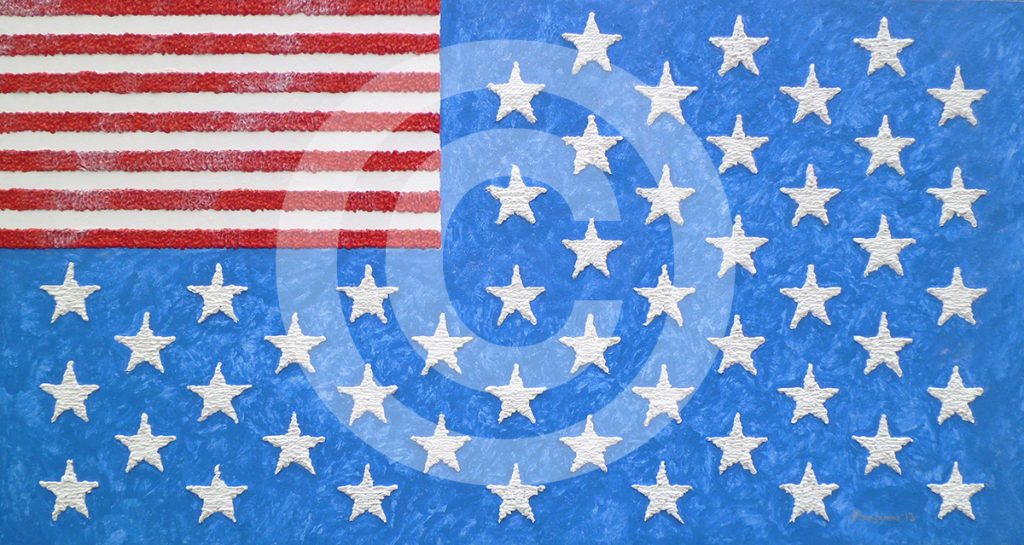
copyright © Arthur Benjamins
Q: How do you think this situation could be resolved?
A: Education – if they are willing to accept. I understand that there is an element of genuine ignorance on this matter. Legislation frightens no one and enforcing it is a prayer without an ending.
Q: Have you ever been approached about infringement you have caused, or sent an email?
A: Twenty+ years ago, a large UK motoring magazine and events organizer commissioned me to depict a famous American racing driver and who would receive this original at a large motoring award. They asked me to directly copy the image from a poster which was taken by one of their freelance photographers, and despite my protestations, they insisted that I did. Several weeks after the award, I received a phone call from that photographer in the USA of whom I knew. I offered him my full explanation, which he accepted. I, since met him at various racing car shows and no ill-feelings remained. However, I remain unhappy that I was asked to copy the image.
COPYRIGHT
Q: What is your view on copyright?
A: There is a distinct and wide spread misconception that any image becomes fully accessible when the original photographer has died or no attribution can be claimed. I have seen many known photographs re-appear in new publications with the author’s name as copyright owner.
As I have said before, education is the only solution.
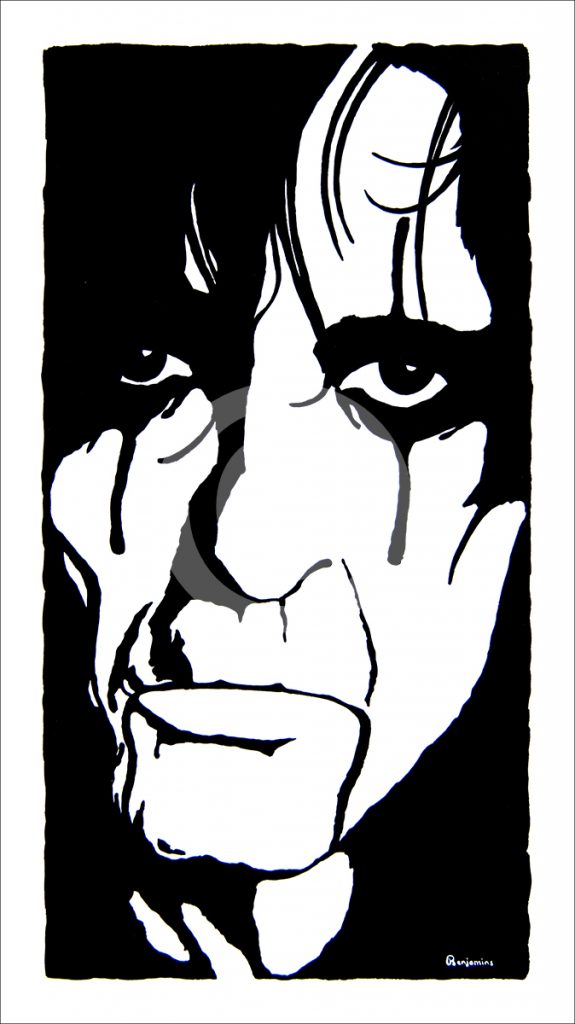
copyright © Arthur Benjamins
Q: Have you ever innocently, or without knowledge of copyrighted laws used other’s material for your own work?
A: Any artist who says he has never been influenced by the works of others, is not true to him/her self. It is the manner in which this influence comes to bear. Is the issue. Over the years, I have elicited the help from photographers and photo bureaus for reference information. Those images were never reproduced in a likewise manner, and which would be recognizable as the original image. I have much history in Land-and Water Speed Record breakers and virtually know every image ever produced over the years. I have seen many artists’ images which are unashamedly direct lift-offs from those images, without even any attempt to disguise. It makes it extra galling when those artists are championed by galleries.
Q: How do you protect your own work against copyright theft?
A: Wikipedia famously insist that you write off every single vestige of ownership to your image, so be prepared that it may be lifted and used at anybody’s ‘discretion’. I have placed the © on some of my images, but I am aware enough to realize that this merely serves as a minor obstacle and that its only function is to impress the masses. Much of my work is represented on the internet in countless ways and countless sites. I expect my work to get ripped off somewhere along the line, however, I feel that the advantages of my work appearing all over the aether vastly outweigh the disadvantages.
Q: Do you think companies on the web do enough to protect artist’s work?
A: It is of no concern to them. Their business is to make money and if any of an artist’s work gets used by third parties, they could not care much.
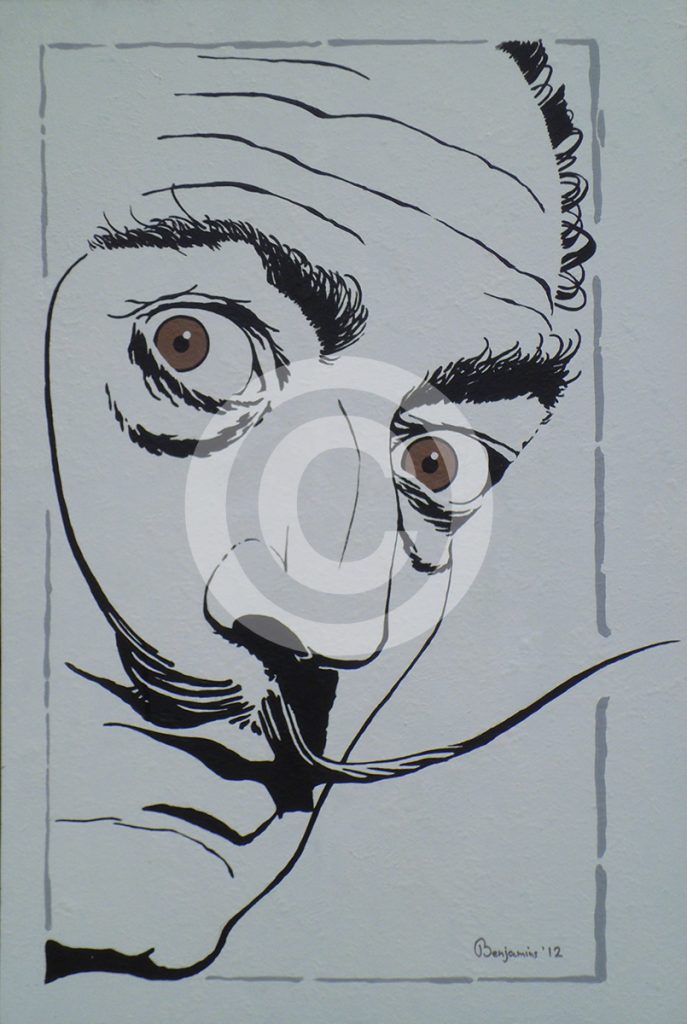
copyright © Arthur Benjamins
Q: What do you think about Creative Commons and Public Domain?
A: I have never given them much mind. My ideas, principles may not run in tandem with theirs, however, I remain totally aware that they may not practice what they preach. What kind of ‘Big Brother’ system should be put in place to police everything?
Q: What do you think of artists that abuse this feature?
A: I see far too many copyists that don’t even claim a ‘springboard’ or transition to their own style. As I have said before, they probably excel in talking the talk to galleries, who are only happy to peddle their wares for them. I say nothing because I know that there will be a time for balancing. People WILL eventually wake up and see the ride they’re been taken on.
Q: Additional thoughts?
A: Over the years I have literally spent thousands in having my images professionally photographed for reproduction purposes. I know what sort of equipment is required, but possess none of them, but I am aware that even the recent cell phones have a very potent system in them and which are improving exponentially. Even ‘Vox Pops’ are usually of excellent quality.
When I began to note regular overt “No Photography” signs on booths at exhibitions, my surprise was directed at the artists who obviously thought that their works were so important, that illegal reproductions were going to be made by the camera-wielding masses, and who ignored the signs, snapping away from the walkways. Those images will never be of sufficient quality to provide bootleggers with income.
The likelihood is much higher that these visitors take them for their own records and to show them to friends, who may all become potential clients. Showing sullen hostility with these signs works to the opposite.
I have made ‘photography welcome’ signs, however, people still ask if they can take snaps. I have engaged various of these visitors in very pleasant conversations, because I KNOW that one day, they WILL become my customers.










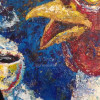
Love the “peek” behind the curtain and the wonderful insights about the internet, marketing, and copy right infringement.